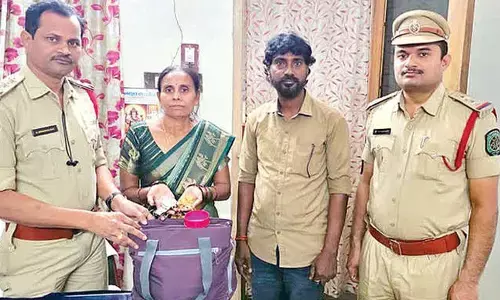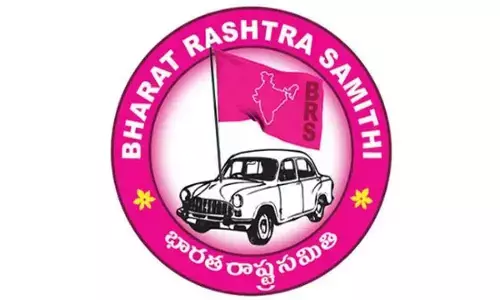Demand rises for opening royal castles in Andhra

The temple town of Amaravati was once ruled by Raja Vasireddy Venkatadri Naidu. He was the man behind establishment of Jaggayyapet and Achammapet on behalf of his parents. He ruled up to 552 villages and towns located on borders of Krishna district including Madhira, Khammam, Kalidindi, Kondapalli, Kondaveedu, Vinukonda, Ponnuru, Nizampatnam and Palivela near Rajahmundry.
Amaravati: The temple town of Amaravati was once ruled by Raja Vasireddy Venkatadri Naidu. He was the man behind establishment of Jaggayyapet and Achammapet on behalf of his parents. He ruled up to 552 villages and towns located on borders of Krishna district including Madhira, Khammam, Kalidindi, Kondapalli, Kondaveedu, Vinukonda, Ponnuru, Nizampatnam and Palivela near Rajahmundry.
He provided large temple towers at Lord Narasimha Swamy temple at Mangalagiri and Amareswara Swamy temple in Amaravati. He built Lord Brahma temple at Chebrolu village near Guntur and installed 108 Sivalingas in temples at various villages in one auspicious muhurat. Raja Vasireddy Venkatadri Naidu was born in 1761 and died in 1816.
Highlights:
- Raja Vasireddy Venkatadri Naidu ruled Amaravati
- Vasireddy Sri Rama Gopala Krishna Maheswara Prasad was the Raja of Muktyala
- He conducted a lot of research on Ayurveda and cancer and published ‘Sri Dhanvantari’ magazine
- Historically important tools, artefacts and knives were housed in Mahendra Vilas in Amaravati
His ancestors like Vasireddy Dasaradhi Naidu, Ramanatha Babu, Mukhyeswara Prasad, Venkatadri Naidu, Uma Maheswara Prasad, Chandra Mouliswara Prasad, Erlagadda Ankineedu Prasad, Mallikharjuna Prasad, Sivarama Prasad and Ramakrishna Prasad once lived in spacious forts and castles in Muktyala, Kondaveedu, Challapalli, Jayantipuram and Kondapalli etc.
Raja Vasireddy Sri Rama Gopala Krishna Maheswara Prasad was the ruler of Muktyala in the early 20th century while Raja Vasireddy Bala Chandrasekhara Varaprasad was the king of Amaravati at the same time.
Vasireddy Rama Gopala Krishna Maheswara Prasad and Bala Chandrasekhara Varaprasad were freedom fighters, known for their interests in poetry, dance, music and Ayurveda.
Maheswara Prasad was the proposer for construction of Pulichintala Project to supply irrigation water to the starving lands, but the then government scrapped the idea as the ayacut was very low.
So, after spending Rs 60 lakh on research to find the best place for an irrigation project, he had identified Nandikonda and initiated proposals for Nagarjuna Sagar project.
He was also the man who had set up ‘Arsha Rasayanasala’, a laboratory where different types of research on cancer was carried out for decades in the three-storeyed Muktyala fort ‘Harihara Vilas’.
As a lover of Buddhism, he also planned setting up museums in Muktyala and Amaravati and collected thousands of artefacts for the purpose.
Vasireddy Bala Chandrasekhara Varaprasad rebuilt the palace in Amaravati and renamed it ‘Mahendra Vilas’ in 1930s. The Muktyala Raja family initially lived for about six months during every year in Amaravati in the Mahendra Vilas.
Subsequently they used to live there for two months and then for 15 days during Sivaratri period. Mahendra Vilas also has a large number of historically important tools, artefacts and knives inherited by the Vasireddy family over generations.
The Harihara Vilas is now being used as a guest house by KCP Cements while the Mahendra Vilas is occasionally used by the Vasireddy family. Vasireddy Venugopal, a senior journalist, said, “The Muktyala Raja was very popular and loved by the people in his domicile.
He was known as a very good soul who worked for the welfare of the common man. He was the man behind the idea of construction of Nagarjuna Sagar and spent lakhs of rupees on research for identifying the best place.”
Venugopal pointed out that Muktyala Raja was a poet, writer and interested in Ayurveda. He did a lot of research on Ayurveda and cancer and published ‘Sri Dhanvantari’ magazine for more than 50 years.
“A number of unpublished research documents and books on cancer, thousands of artefacts of Buddhism lie in the fort and they are the property of the Andhra Pradesh people.
The government should initiate steps to open the fort for common public and display the hundreds of years of old history for reference to younger generations,” he said.

















